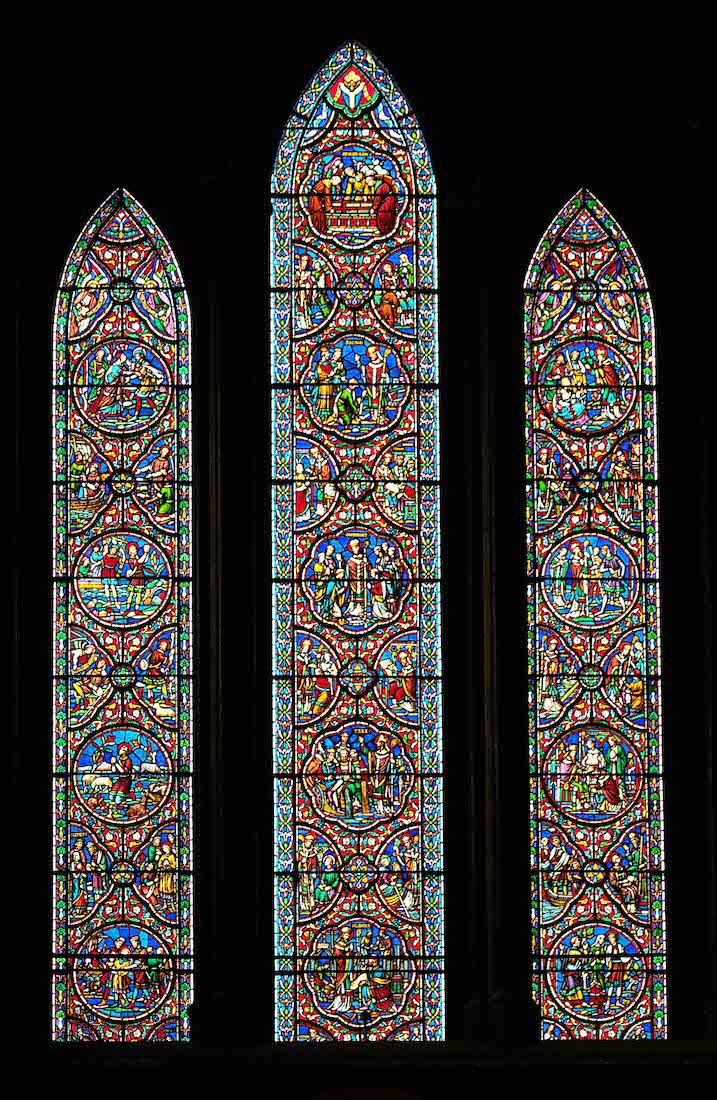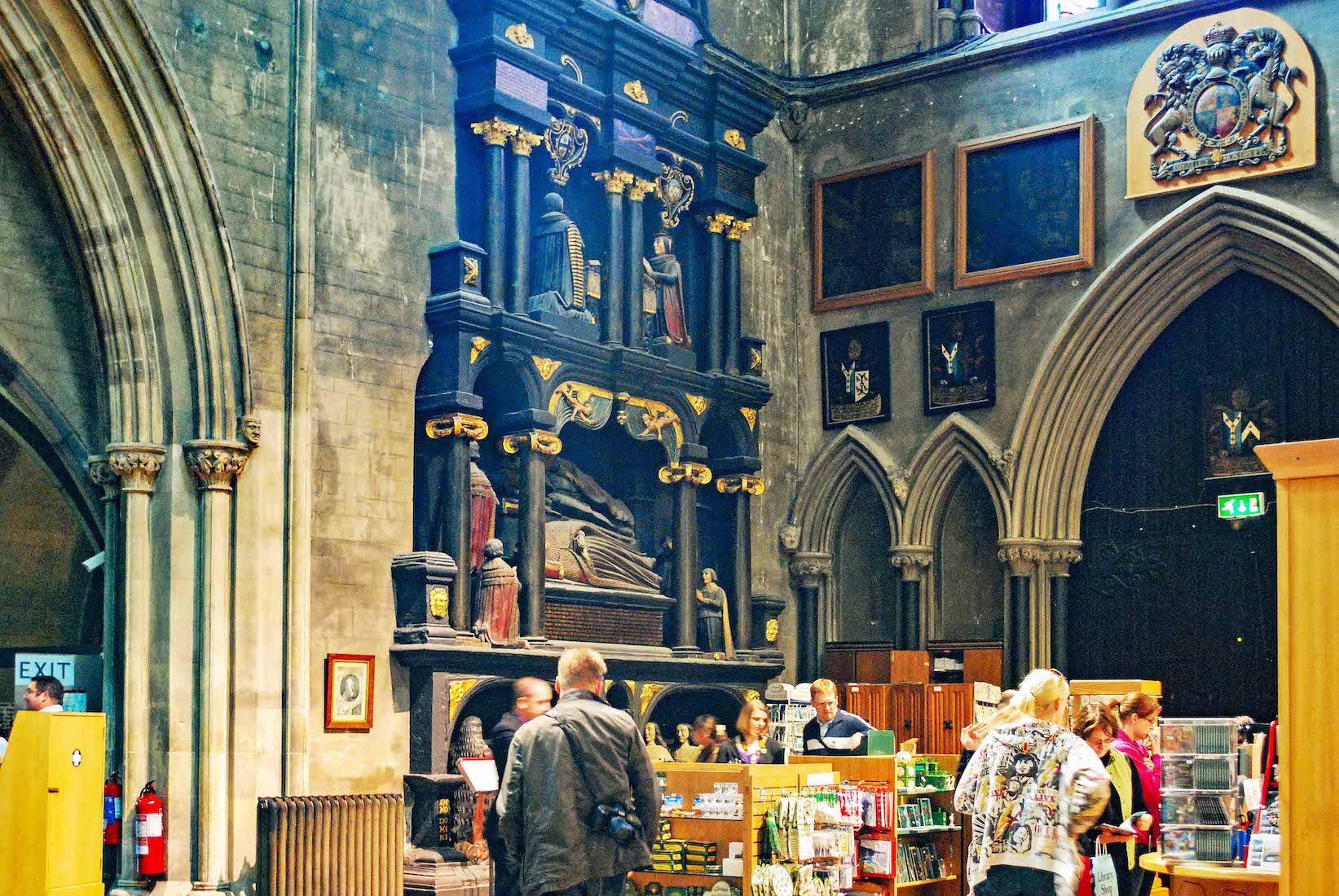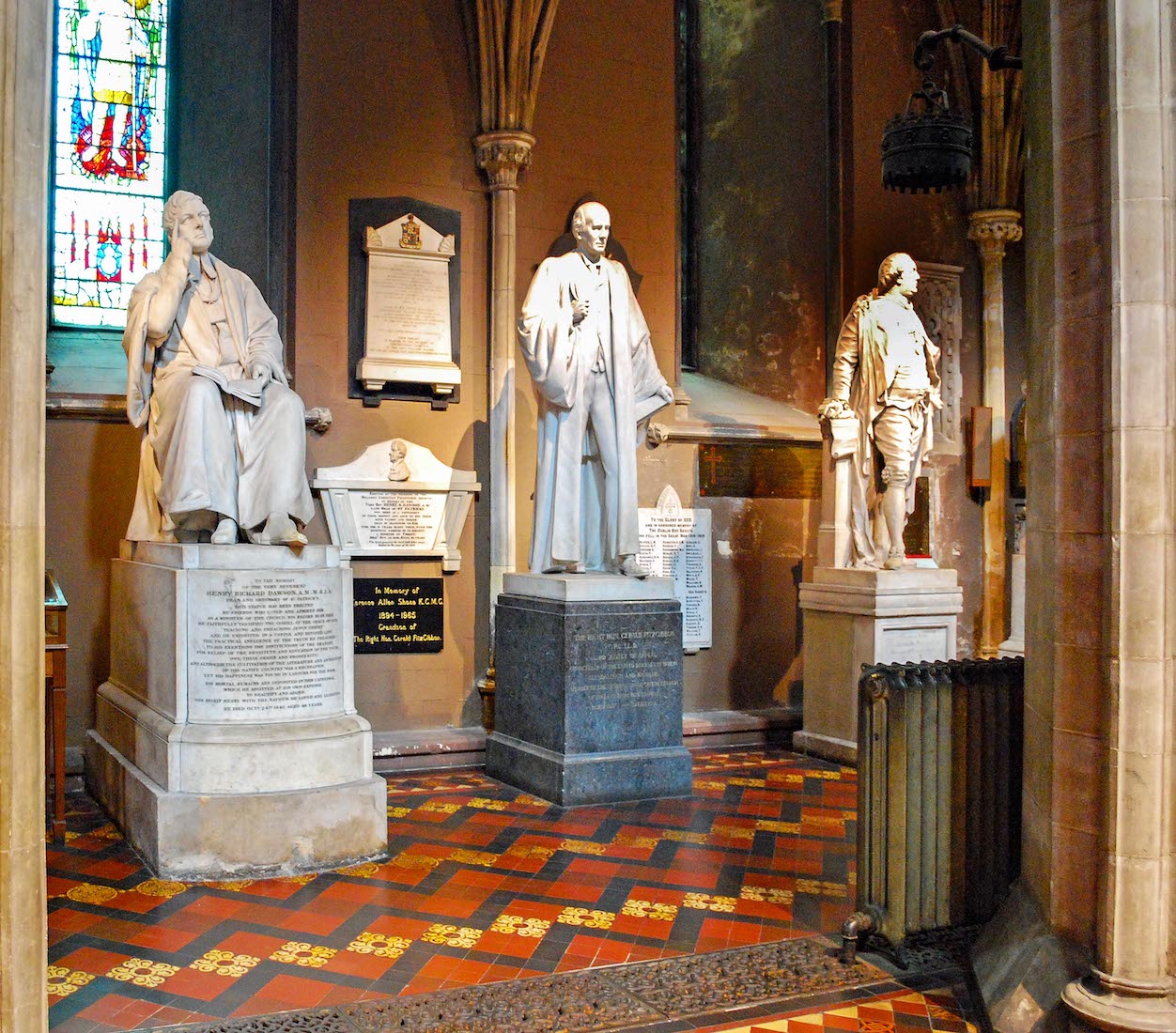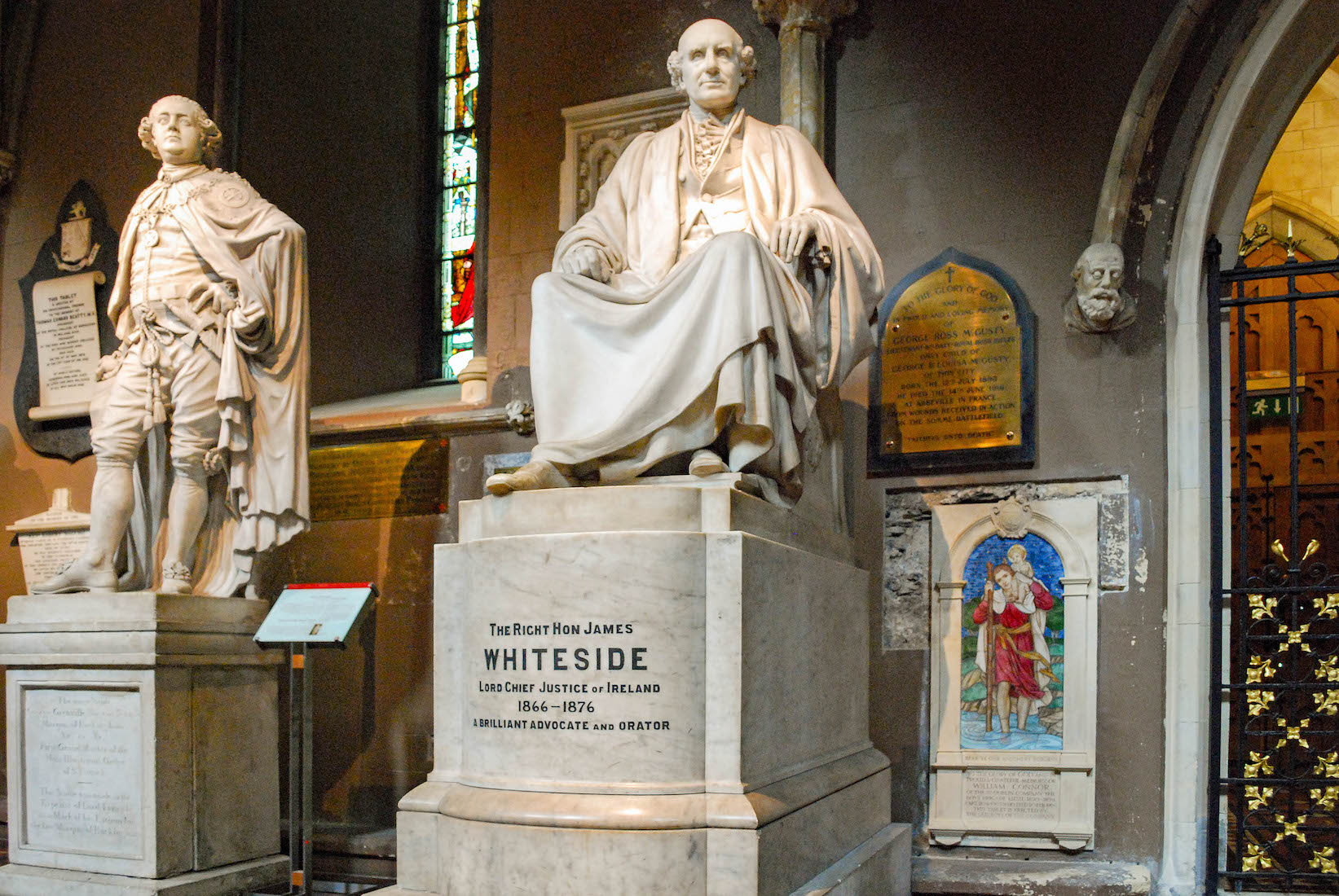21. SOUTHWEST ENTRANCE LM W-LNS

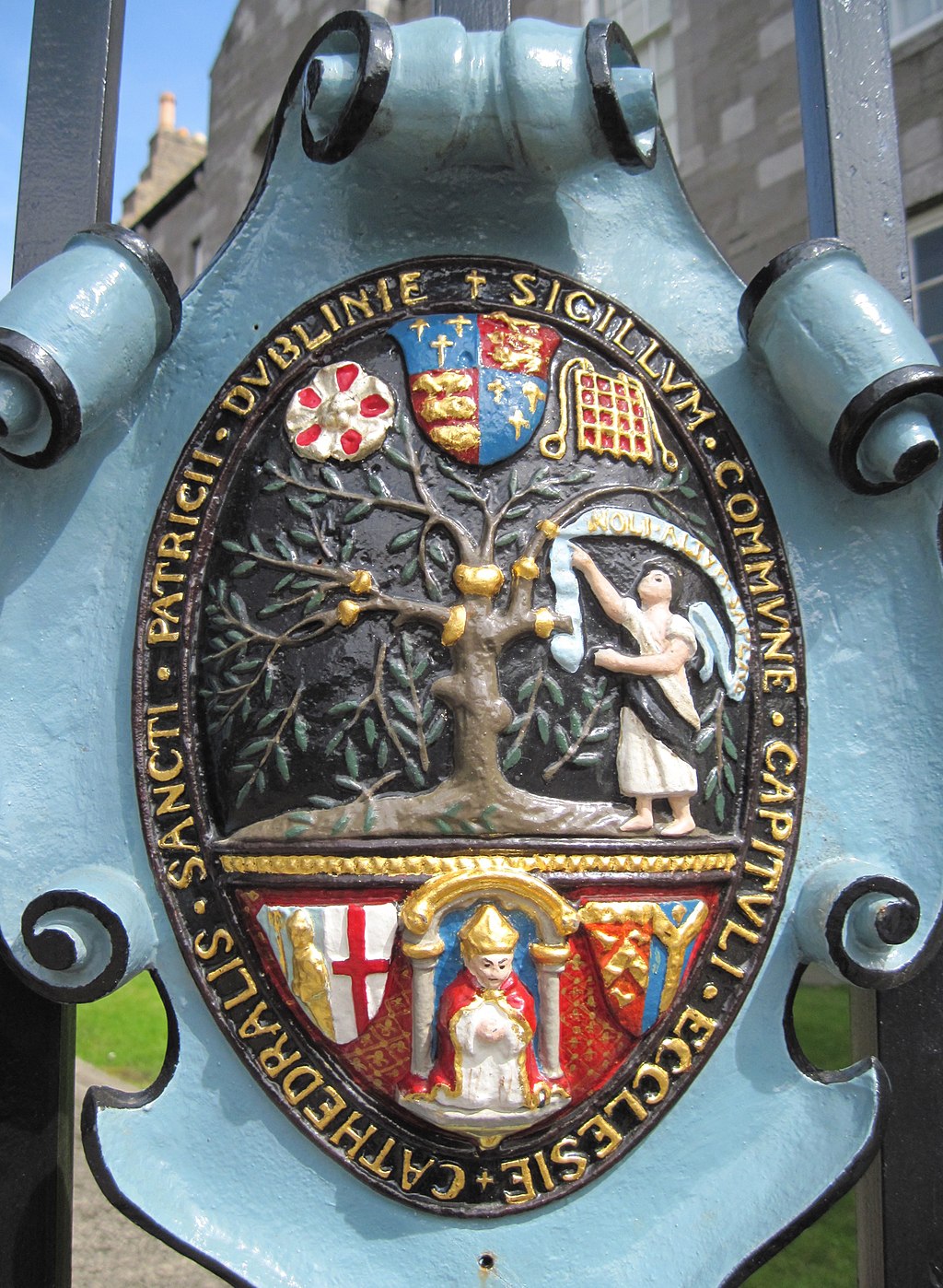
Beyond the outside door of the South entry, steps lead down into the Cathedral. As with many cathedrals, there is a private room up above the entry porch •• At right is the Cathedral crest, attached to the entry gates. [Photo2 Credit: Wikimedia Leslie Noelle Sullivan] INDEX
22. LOOKING OUT THE ENTRY DOORS LM
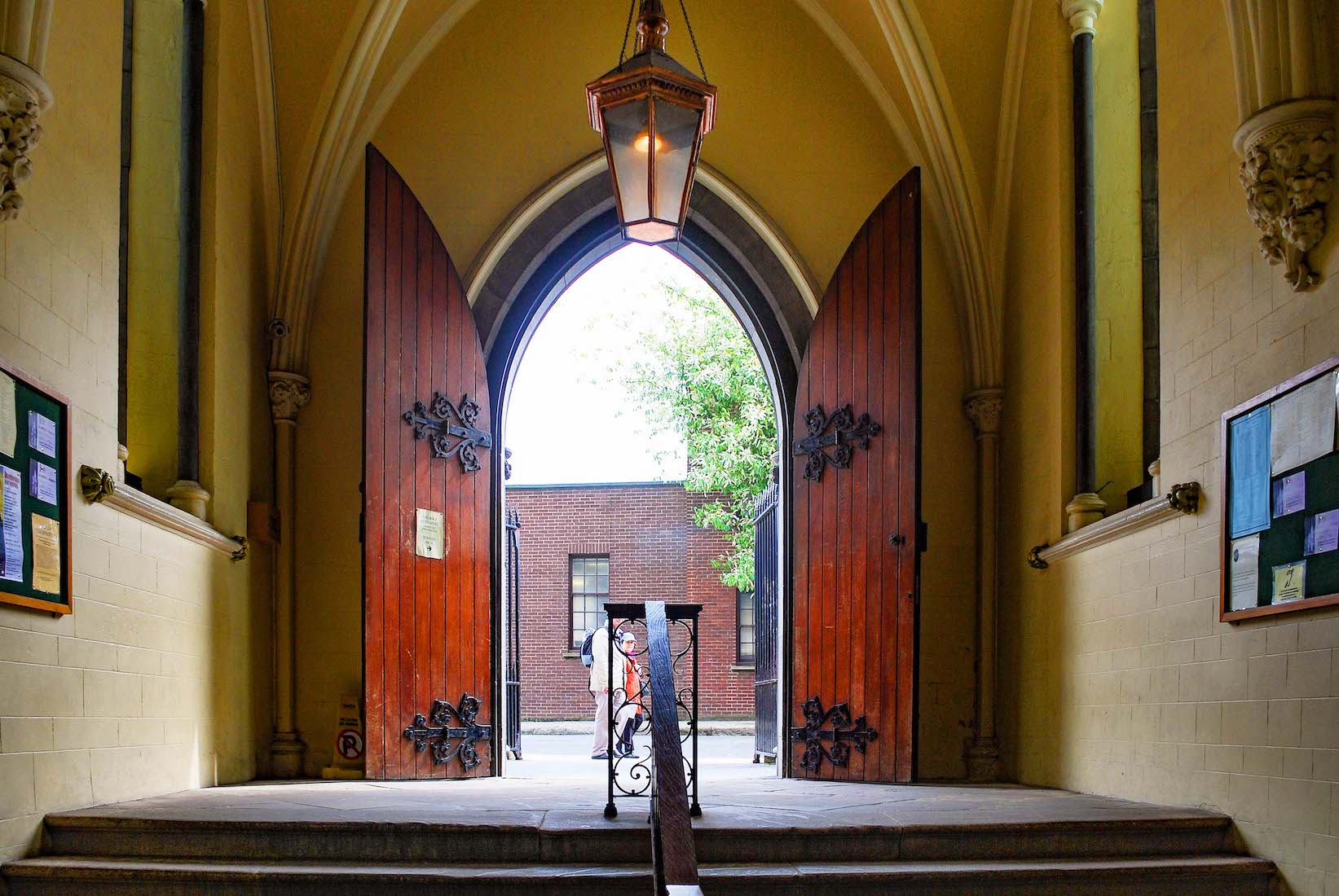
Looking back up the entry steps: there is no wheelchair access this way! Designers of early cathedrals never thought about these things ... .
23. BAPTISTRY JH WG
To our immediate left is the baptistry. The baptistry is located in the oldest part of the cathedral. It may have been part of the entrance to the church that existed on the site prior to the construction of the Cathedral. The vaulting is obviously earlier and cruder than in the rest of the cathedral , and the floor tiles are old. The three-lancet window by Casey Bros, Dublin, dates from 1865. It shows from left St Paul, St Patrick and St Peter. [Photo1 Credit: James Hundt Architect]
24. NAVE LM
Leaving the baptistry we make our way to the West end of the nave. Our eyes follow the brilliantly tessellated central aisle, between the large pulpit and smaller lectern, through the choir with its hanging regimental colours, past the altar to the lovely windows of the Lady Chapel in the distance. Above is an attractive triforium colonnade, and five high apse lancets. This is a colourful and appealing worship space.
25. NAVE VAULTING LM
The nave has a solid brick ceiling supported by simple vaulting: quadripartite rib vaults with simple linear rib supports across between. There are undecorated bosses along the centre line.
26. NAVE LOOKING WEST LM
Walking to the front of the central nave aisle and looking back we see the Great West Window with a coat of arms and various memorials below. The Cathedral shop has been set up here as well.
27. WEST WINDOW WG
This is a complex window with three lancets and 39 scenes from the life of St Patrick! It dates from 1865 and comes from the studio of William Wailes, Newcastle-upon-Tyne. It was installed as part of the Guiness redecoration.
28. WEST WINDOW AND BELOW LM LM
Below the West window is a wooden carving of the Royal Coat of Arms – a reminder of past times – framed remnants of Regimental colours, and various ecclesiastical coats of arms.
29. BOYLE MONUMENT LM W-AFB
To the left of the West window and below, is the large Boyle monument. This was erected in 1632 by Richard Boyle, 1st Earl of Cork, for himself, his wife and family. The size of the monument was offensive to many, and it has been dismantled and moved several times. [Photo2 Credit: Wikipedia Andreas F. Borchert]
30. FLOOR TILES LM
St Patrick’s Cathedral has an amazing set of colouful floor tiles. This seems to be a feature of many Irish cathedrals. In fact the tile in St Patrick’s are all relatively new, dating from 1865 during the Guiness redecoration. New tiles were created, based on original medieval designs.
31. MOVING TIME? GSV W-RH
At the time of our visit some ‘works’ were being undertaken. Our interest is in the Northwest corner of the nave, and exploring along the North aisle. The corner window (1872) has three lancets and was made by Heaton, Butler and Bayne, London. The top panels depict the stoning of Stephen. Below, from left to right are: St Bartholomew, St Thomas, St Peter, St Paul, St James and St John. [Photo2 Credit: Wikimedia Rob Hurson]
32. JOHN PHILPOT MEMORIAL LM
Adjacent to the window is a memorial to John Philpot. Curran (1750 – 1817). He was born in Cork, and was an Irish politician and judge.
33. JONES AND CAROLAN MONUMENTS LM LM
Moving along the North wall we come to the large Jones monument, and then an interesting tribute to Carolan. Thomas Jones (ca 1550 – 1619( was Archbishop of Dublin and Lord Chancellor of Ireland. He was also Dean of St Patrick’s Cathedral and Bishop of Meath. •• Carolan is described as the last of the Irish bards. Turlough O'Carolan (1670 – 1738) was a blind Celtic harp player, composer and singer in Ireland whose great fame is due to his gift for melodic composition.
34. STONE AND STATUE LM LM
Moving back into the nave a little, we stand between a special stone and a statue of St Patrick. The stone, inscribed with a Celtic cross, was found in 1901 on the site of St Patrick’s Well in the adjacent Park. (Ignore the background of this photo: this stone has a tendency to move around the Cathedral!) •• The bronze statue of St Patrick was sculpted in 1941 by Melanie le Brocquy, and cast in 2001. It is the gift of Bishop Edwin Owen.
35. NORTH NAVE AISLE GSV
Along the North aisle is a series of six statues of prominent people. Four are shown here: a further two are to our left.
36. DAWSON, FITZGIBBON, GRENVILLE STATUES LM
There are a great number of monuments in this Cathedral, so we look here at the large statues. •• At left is a statue of Henry Richard Dawson (1792 – 1840) who was Dean and Ordinary of St Patrick’s. •• Next is a statue of Gerald Fitzgibbon. Gerald FitzGibbon PC (1837 – 1909) was an Irish barrister and judge, who is regarded as one of the outstanding Irish jurists of his time. He came from a family which produced three generations of eminent lawyers, with the father, son and grandson each bearing the name Gerald FitzGibbon. •• We return to the Grenville statue shortly.
37. NORTH NAVE WINDOWS WG WG
The two Western-most windows of the North aisle are shown here. The left window shows the Archangel Michael. It dates from 1901 and was made by Burlison & Grylls, London. •• The window at right shows St Gregory (top) and King David (bottom). Itr was made in 1898 by A.L. Moore & Co., London.
38. GRENVILLE, WHITESIDE STATUES LM
At left is a statue of George Nugent-Temple-Grenville,1st Marquess of Buckingham, KG, KP, PC (1753 – 1813). He was known as George Grenville before 1779 and as The Earl Temple between 1779 and 1784; he was a British statesman. •• James Whiteside (1804 – 1876) was an Irish politician and judge. He held a number of important positions.
39. BOYD AND OGLE STATUES GSV LM
At left is the statue of John McNeill Boyd. He was a sailor for most of his life, quickly working his way through the ranks of the Royal Navy. He died heroically trying to save the lives of fellow sailors during some of the worst storms ever to hit the east coast of Ireland. He is buried in the graveyard of Saint Patrick’s Cathedral. •• At right is a statue of George Ogle. George Ogle (1742 – 1814) was an Irish Tory politician. He had literary tastes and composing two songs which are still popular. •• At right is the Wesley silver flagon and chalice, replicas of those used by John Wesley when he visited the Cathedral in 1775. Wesley wrote in his diary in April 1775: ‘The good old Dean of St Patrick’s desired me to come within the rails and assist him at the Lord's Supper. This also was a means of removing much prejudice from those who were zealous for the Church.’
40. MORE NORTH NAVE WINDOWS WG WG
There are two more windows along this North nave wall. At left we see Christ with Martha, and Christ appearing to the eleven disciples. This 1907 window was produced by James Powell & Sons, London. •• The window at right depicts Christ in Glory, and the angel with the women at the tomb. The window was produced in 1895 by Heaton, Butler & Bayne, London.







